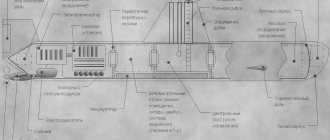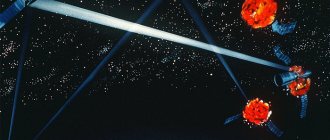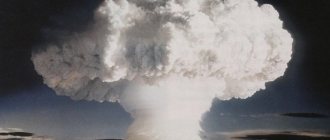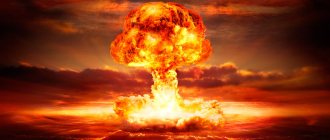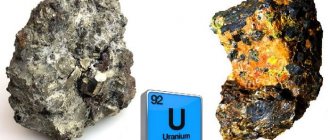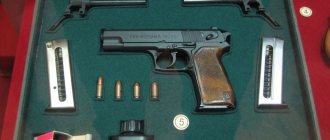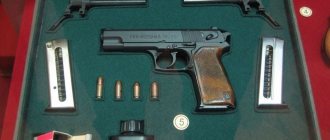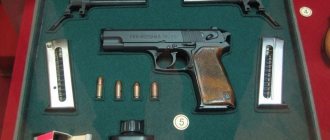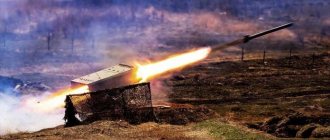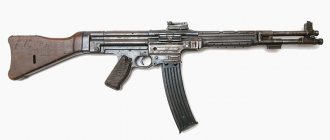After the end of World War II, humanity almost immediately fell into a new protracted conflict, in an era of confrontation between two global military-political blocs - the communist one, led by the Soviet Union, and the western one, led by the United States of America. This period lasted more than forty years and was called the Cold War.
At the end of World War II, the United States managed to create nuclear weapons, and a few years later the Soviet Union also acquired them. After this, both countries entered into a mad nuclear arms race, building up their arsenals and creating ever more advanced means of delivering thermonuclear charges. Several times, humanity literally stood on the edge, only a few millimeters separated it from atomic Armageddon.
The Cold War gave rise to numerous phobias: the West was afraid of Soviet tank armadas and nuclear submarines, and in the USSR they frightened citizens with Pershings and Tomahawk cruise missiles. One of the main horror stories of the Cold War was the cobalt bomb - a new type of nuclear weapon capable of not only incinerating the earth, but also turning it into a radioactive desert for many decades. This term did not disappear without a trace along with the Cold War era; materials about the cobalt bomb can still be easily found on the Internet today. Sometimes it is called a “dirty” bomb, which, in general, is not entirely true.
Does this type of nuclear weapon really exist? On what principles does a cobalt bomb “work” and why is it dangerous? Are similar weapons being developed today?
Reality or myth
The idea of destroying the enemy with radioactive radiation originated a long time ago. It should be noted that the idea of creating a cobalt arsenal came not to scientists and military personnel, but to the famous American science fiction author Robert Heinlein.
In 1940, while a not very famous writer wrote a story, it told the story of the powers that were part of the anti-Hitler coalition, which bombed Germany with radiological weapons. This unexpected blow forced the Germans to capitulate.
An interesting fact is that in the story, the creation of a nuclear warhead failed, which is why the Allies used a “dirty” bomb. At that time, military officers and scientists were confident that it was impossible to create such weapons.
The idea of a cobalt bomb was described by physicist Leo Szilard in the 1950s. He suggested that the use of such a projectile would lead to the death of all life on planet Earth. It should be noted that the existence of a cobalt bomb has not yet been officially confirmed by anyone.
Writers and screenwriters widely use this ammunition in their creations. They show the consequences awaiting humanity after the use of such weapons. Maybe for this reason, the idea of creating a cobalt bomb remains only an idea on paper.
Cobalt isotope table
| Nuclide symbol | Z(p) | N(n) | Isotope mass (a.mu.) | Half-life(T1/2) | Spin and parity of the nucleus |
| Excitation energy | |||||
| 47Co | 27 | 20 | 47,01149 | 7/2- | |
| 48Co | 27 | 21 | 48,00176 | 6+ | |
| 49Co | 27 | 22 | 48,98972 | 35 ns | 7/2- |
| 50Co | 27 | 23 | 49,98154 | 44 ms | 6+ |
| 51Co | 27 | 24 | 50,97072 | 60 ms | 7/2- |
| 52Co | 27 | 25 | 51,96359 | 115 ms | 6+ |
| 52mCo | 380 keV | 104 ms | 2+ | ||
| 53Co | 27 | 26 | 52,954219 | 242 ms | 7/2- |
| 53mCo | 3.197 MeV | 247 ms | 19/2- | ||
| 54Co | 27 | 27 | 53,9484596 | 193.28 ms | 0+ |
| 54mCo | 197.4 keV | 1.48 min | 7+ | ||
| 55Co | 27 | 28 | 54,9419990 | 17.53 h | 7/2- |
| 56Co | 27 | 29 | 55,9398393 | 77,233 days | 4+ |
| 57Co | 27 | 30 | 56,9362914 | 271.74 days | 7/2- |
| 58Co | 27 | 31 | 57,9357528 | 70.86 days | 2+ |
| 58m1Co | 24.95 keV | 9.04 h | 5+ | ||
| 58m2Co | 53.15 keV | 10.4 µs | 4+ | ||
| 59Co | 27 | 32 | 58,9331950 | stable | 7/2- |
| 60Co | 27 | 33 | 59,9338171 | 5.2713 g | 5+ |
| 60mCo | 58.59 keV | 10,467 min | 2+ | ||
| 61Co | 27 | 34 | 60,9324758 | 1,650 h | 7/2- |
| 62Co | 27 | 35 | 61,934051 | 1.50 min | 2+ |
| 62mCo | 22 keV | 13.91 min | 5+ | ||
| 63Co | 27 | 36 | 62,933612 | 26.9 s | 7/2- |
| 64Co | 27 | 37 | 63,935810 | 300 ms | 1+ |
| 65Co | 27 | 38 | 64,936478 | 1.20 s | 7/2- |
| 66Co | 27 | 39 | 65,93976 | 180 ms | 3+ |
| 66m1Co | 175 keV | 1.21 µs | 5+ | ||
| 66m2Co | 642 keV | 100 µs | 8- | ||
| 67Co | 27 | 40 | 66,94089 | 425 ms | 7/2- |
| 68Co | 27 | 41 | 67,94487 | 199 ms | 7- |
| 68mCo | 150 keV | 1.6 s | 3+ | ||
| 69Co | 27 | 42 | 68,94632 | 227 ms | 7/2- |
| 70Co | 27 | 43 | 69,9510 | 119 ms | 6- |
| 70mCo | 200 keV | 500 ms | 3+ | ||
| 71Co | 27 | 44 | 70,9529 | 97 ms | 7/2- |
| 72Co | 27 | 45 | 71,95781 | 62 ms | 6- |
| 73Co | 27 | 46 | 72,96024 | 41 ms | 7/2- |
| 74Co | 27 | 47 | 73,96538 | 50 ms | 0+ |
| 75Co | 27 | 48 | 74,96833 | 40 ms | 7/2- |
| 76Co | 27 | 49 | > 634 ns |
Design and Application
A nuclear explosion produces a certain number of different radioactive isotopes. Many of them have a short half-life, so the radiation can drop significantly in a matter of hours after the explosion.
You can wait out this period in a special bunker, and after a few years the affected areas can again be used for economic activity.
This can be seen in the example of the cities of Hiroshima and Nagasaki, raised from ruins 4 years after the atomic bombing.
A cobalt bomb, in theory, is a type of nuclear weapon; from its use, territories are contaminated with radioactive elements (even after a weak explosion). It is a means of mass destruction, not instantaneous. A bomb or other ammunition is a thermonuclear charge, the last shell of which contains not uranium-238, but cobalt. The design was proposed by the American scientist Szilard.
Cobalt is a naturally occurring mineral, a monoisotopic element consisting of 100% cobalt-59. From the explosion, the shell is irradiated with a strong neutron flux, from which the cobalt-59 core becomes a radioactive isotope of cobalt-60, its half-life lasts more than five years.
Pundits have even calculated how much cobalt is needed to completely destroy our planet. It turned out that 510 tons of cobalt-60 isotope would be enough, and no bunker could save us from this.
The design of the first “dirty” bomb was similar to those described by science fiction author Heinlein: ordinary containers stuffed with radiological material (previously obtained as a result of synthesis) and an explosive charge.
At a certain height, the shell exploded, spreading isotopes. Szilard proposed his design a little later.
A term was coined for radiological weapons: a doomsday machine. They do not need to bomb an enemy state; it will be enough to blow it up on their own, and the radioactive contamination will spread across the earth in a few months by atmospheric currents. True, the people of the country that detonated the bomb will die first.
Presumably, no country yet has such ammunition in service, but some claim that Russian scientists are developing a cobalt bomb. It is not possible to establish what really is; all statements are based on rumors that are refuted by the Kremlin.
It becomes very scary to think that humanity so little values its existence on planet Earth. In the race for superiority in weapons, people forget that no one can survive after using such weapons.
Disassembly
Partial disassembly is necessary when cleaning and lubricating TOZ-120. The full one is made only for repairs and only in a weapons workshop.
Partial implies the following actions:
- check that there are no cartridges in the chamber;
- press the latch and, moving the forend down and forward, remove it from the barrels;
- turn the locking lever to the right, open the barrels and disconnect them from the box;
- bring the lever to the right to the limit, retract the pusher and release the lever so that it returns to the position along the axis.
TOZ-120 is assembled in the reverse order.
Store the gun unloaded with the hooks lowered. Ammunition must be stored separately.
Features of the mushroom
The puffball - the giant bighead - has many features. This mushroom is very beneficial for the body. Its main feature is the absorption of radionuclides, as well as heavy metal salts. After eating a dish prepared from a raincoat, harmful substances quickly leave the body naturally.
It is worth noting that due to this property, golovach is used for the manufacture of dietary supplements. As practice shows, such products cleanse the body well, restore the skin and make it more elastic. If you wish, you can prepare a delicious dish from golovach at home.
Where were cluster shells used?
Cluster shells were used by the US military during the Korean War. To do this, they used SD-2 ammunition already known from the Germans, which was slightly modified and renamed AN M83. Later, American developers came up with new bombs called Blu 26/B. At that time, these were round ammunition made of lightweight alloy. Moreover, their filling included up to three hundred 5.5-mm balls made of natural steel. And this innovation had a certain effect on the explosion of a cluster bomb.
In addition, cluster bombs were used in Syria, Libya, Yugoslavia and other countries where there was military conflict. Not long ago, people started talking about these dangerous and prohibited projectiles in Ukraine.
Similar aerial bombings were also discussed in the media during recent events in Yemen.
Who benefits from this?
As far as is known, no state officially has radiological weapons. It is unprofitable for traditional wars: a “dirty bomb” does not allow you to destroy the enemy instantly, like other types of weapons, its effect is extended over time, in addition, for many years it makes the territory unsuitable for capture and use - and even for sending troops. As a deterrent weapon, a dirty bomb is also not the best option when there are missiles with nuclear warheads.
However, while the “dirty bomb” is not suitable for either “hot” or “cold” armed confrontation, it is quite suitable for groups waging war by unconventional methods, primarily terrorist ones. Radiological weapons make it possible to inflict maximum damage on civilians - therefore, they are an ideal means of deterrence. On September 11, 2001, during the largest terrorist attack under the ruins of the Twin Towers, almost 3,000 people died. If a medium-power “dirty bomb” had exploded in the same place, the number of casualties would have gone into the millions. The National Geographic Channel produced a 40-minute video showing the consequences of a hypothetical explosion of a small American-strontium “dirty bomb” in the middle of an American town - it clearly simulated the consequences of such an explosion.
Another dubious advantage of this type of weapon is its availability. In one of the publications on this topic, the “dirty bomb” was incorrectly, but very aptly called “an atomic bomb for the poor.” Only eight countries in the world have nuclear weapons. In order to make a real atomic bomb, you need resources that only developed countries have: research laboratories, high-tech production, and finally, weapons-grade uranium or plutonium, which cannot be obtained so easily. A “dirty” bomb can be made literally “on the knee”. Radioactive isotopes are now used very widely: in industry and energy, in medicine, in science and even in everyday life (for example, smoke detectors are often made based on americium-241), so if you want to obtain enough radioactive substances to make a bomb, it is not a problem. It is no coincidence that during US military operations in the Middle East and in the camps of Chechen militants, as the press writes, drawings of “dirty bombs” were found more than once (however, the latter could be a “duck”).
There is another unpleasant scenario, similar in effect to the use of radiological weapons: a terrorist attack with an ordinary explosion at a nuclear power plant.
Today, when the danger of terrorist attacks is high, people need to know what is happening and how to behave in the event of explosions, including explosions of “dirty bombs”. Apparently, here it is worth directing readers to the National Geographic film, which is called “Dirty Bomb”. And although the film demonstrates the actions of the American civil defense system, the Russian viewer can also glean a lot of useful information from it.


